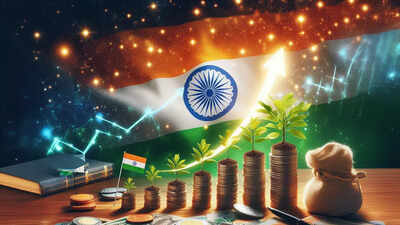ARTICLE AD BOX

In the short-term, good macro health and a supportive policy environment provide resilience. (AI image)
By Dipti Deshpande and Sharvari RajadhyakshaThe world is navigating choppy waters, with geopolitical thrust and parry, tariff tussles and supply-chain shifts reshaping trade flows and pricing dynamics. The turbulence thus far has spawned three major aftermaths: heightened uncertainties, slowing global growth and diverging monetary policies.For India, which is more integrated with the global markets than ever before, these jolts carry both direct and indirect costs.In the short-term, good macro health and a supportive policy environment provide resilience. But tariff hikes are a potent threat because they spawn unpredictable changes in the supply chains. Private investments worldwide are already weighed down by the raft of uncertainties. In June 2025, the GDP-weighted World Uncertainty Index spiked to 3x the pre-Covid-19 pandemic level and more than 4x its Global Financial Crisis level. Such elevated uncertainties and reciprocal tariffs are expected to slow global growth, particularly in the US, India’s largest trade partner.S&P Global forecasts global growth at 2.9% in 2025, compared with 3.3% in 2024, while for the US, growth is seen slipping a good 110 basis points (bps) to 1.7% from 2.8% in 2024.
India’s widening tariff differentials with competitors could further curtail its exports.The country’s services sector, which accounts for nearly half of the country’s total exports, offers some cushion, though, logging a robust growth of 11% in 2024 and 12.1% in the first half of 2025. The sector remains outside the purview of US tariffs. Over time, new trade agreements, including with the UK, could provide additional support.Then there is a bigger threat lurking in the global monetary sphere.Diverging policy paths have required investors to navigate complex landscapes, making capital flows volatile. In 2025, the US Federal Reserve has kept rates unchanged, while a good number of central banks have cut rates in 2025. Central banks in EU, India, China, New Zealand, South Korea have recently paused policy moves, whereas the UK, Australia, Russia, Chile, Mexico have continued cutting rates.
In contrast, Japan and Brazil have raised rates this year.
These shifts reflect differing domestic growth and inflation dynamics. Yet the Indian rupee has largely held its ground against the US dollar. For sure, it has been a wee weaker of late, but still rangebound.Through these temblors, the Indian economy has displayed resilience because of its five domestic strengths.First, domestic demand is improving because of another good monsoon year and rising rural incomes, income tax relief to the middle-income consumers, and front-loading of government capital spending. So much so, the Reserve Bank of India estimates all the four quarters of the current fiscal year (April 1, 2025, to March 31, 2026) will see more than 6% GDP growth.Second, low inflation — averaging 2.4% this fiscal — is offering the central bank the elbowroom to cut rates and boost growth.A 100-basis points reduction in the repo rate, a similar slash in the cash reserve ratio via four tranches of 25 bps each, another likely cut in the repo rate, and sufficient-to-surplus liquidity in the banking system are ensuring that the transmission of the rate cuts downstream has been relatively faster in the current easing cycle.Third, a healthy financial system, powered by greater resilience in the banking sector because of the low level of bad loans and high provisioning coverage ratios, has improved the ability of banks to lend.The gross non-performing assets (NPAs) of banks have declined to 2.3% of loans outstanding as of fiscal-end 2025, compared with over 8% five years back. Crisil Ratings believes that while NPAs are bottoming out, they are seen rangebound in fiscal 2026.Fourth, the corporate sector balance sheets have strengthened after a long spell of deleveraging. Not surprisingly, credit rating default rates are at multi-year lows and financial flexibility way better than before.The overall annual default rate for the Crisil Ratings portfolio stood at a 17-year low of 0.7% in fiscal 2025, while median gearing is estimated at ~0.5 time as of fiscal-end 2025, compared with over 1 time a decade back. Fifth, low external vulnerabilities are further cushioned by benign oil prices. That said, headwinds persist.Domestic consumption demand is supporting the economy but remains uneven with rural demand staging a faster recovery than urban. Private investments remain sluggish like at the global level, and this is precluding a faster growth rebound.We maintain that India’s economy will likely grow at 6.5% in fiscal 2026, apace with last year, but with a slim margin of comfort.
The global uncertainties assign a mild downside to this forecast.The nature and intensity of global shudders demand constant vigilance and proactive policy responses, such as building guardrails against adverse tariff blows.India’s medium-term resilience will hinge on raising its manufacturing competitiveness, diversifying export baskets and markets, and deepening free trade agreements. With its medium-term outlook intact so far, India will continue to be the fastest-growing large economy. By fast-tracking infrastructure upgrades, streamlining regulations and deepening trade partnerships, India can row past the stormy waters and ensure a stronger, more sustainable growth trajectory in the decade ahead.The authors are Principal Economist and Junior Economist, respectively. Views are personal.



.png)
.png)
.png)
















 2 days ago
4
2 days ago
4









 English (US) ·
English (US) ·